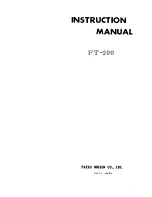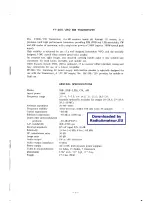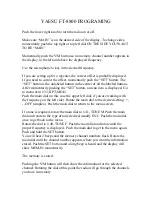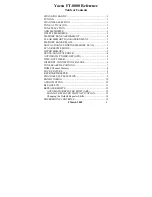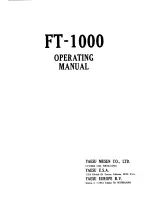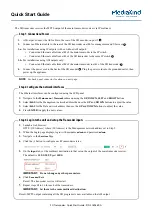
11
Circuit Description
Receive Signal Path
Incoming RF from the antenna jack is passed through
a low-pass filter and high-pass filter consisting of coils
L1023, L1024, L1025, L1039, L1030 & L1031, capaci-
tors C1260, C1266, C1267, C1269, C1270, C1272, C1273,
C1274, C1276, C1278 & C1281 and antenna switching
diodes
D1034
and
D1036
(both
RLS135
) to the receiver
front end section.
Signals within the frequency range of the transceiver
is applied to the receiver front end which contains RF
amplifier
Q1067
(
2SC5226
) and varactor-tuned band-pass
filter consisting of coils L1012, L1014, L1018, L1019,
L1027 & L1028, capacitors C1209, C1211, C1212, C1217,
C1221, C1225, C1228, C1236 & C1275, and diodes
D1029
,
D1031
,
D1032
&
D1040
(all
HVU350
), then
applied to the 1st mixer
Q1068
(
2SC5226
).
Buffered output from the VCO is amplified by
Q1030
(
2SC5226
) to provide a pure 1st local signal between 143.4
and 172.4 MHz for injection to the 1st mixer. The 35.4
MHz 1st mixer product then passes through monolithic
crystal filter
XF1001
(
35S15A
, 7.5 kHz BW) which strips
away all but the desired signal, which is then amplified
by mixer postamp
Q1060
(
2SC4215Y
).
The amplified 1st IF signal is applied to the AM/FM
IF subsystem IC
Q1052
(
TK10931V
), which contains
the 2nd mixer, 2nd local oscillator, limiter amplifier, noise
amplifier and AM/FM detector.
A 2nd local signal is generated by PLL reference/2nd
local oscillator
Q1045
(
2SC4116GR
) from the 17.475
MHz crystal
X1002
to produce the 450 kHz 2nd IF when
mixed with the 1st IF signal within
Q1052
. The 2nd IF
then passes through the ceramic filter
CF1001
(
CFWM450D
) to strip away unwanted mixer products.
In the FM mode, a 2nd IF signal from the ceramic fil-
ter
CF1001
applied to the limiter amplifier section of
Q1052
, which removes amplitude variations in the 450
kHz IF before detection of the speech by the ceramic dis-
criminator
CD1001
(
CDBM450C24
). Detected audio
from
Q1052
is passed through the de-emphasis, consist-
ing of the resistors R1102, R1105, R1111 & R1162, ca-
pacitors C1100, C1101, C1103 & C1145, and
Q1028
(
NJM2904V
), then applied to the AF amplifier
Q1028
(
NJM2904V
).
In the AM mode, detected audio from
Q1052
is passed
through the audio amplifier
Q1028
(
NJM2904V
) and
ANL circuit, then applied to the AF amplifier Q
Q1028
(
NJM2904V
). When impulse noise received, a portion of
the AM detector output signal from the AM/FM IF sub-
system
Q1028
, including pulse noise is rectified by
D1019
(
BAS316
). The resulting DC is applied to the ANL
MUTE gate
Q1029
(
UMG2N
), thus reducing the pulse
noises.
The processed audio signal from
Q1028
passes
through the audio mute gate
Q1016
(
DTC124TU
) and
the volume control to the audio power amplifier
Q1009
(
TDA72330
), providing up to 0.4 Watts to the headphone
jack or 8
Ω
loudspeaker.
A portion of the AF signal from the AM/FM IF sub-
system
Q1052
converted into DC voltage within the IC,
and then passes through the AGC amplifier
Q1059
(
2SA1602A
) and
Q1062
(
UMW1
) to the inversion ampli-
fiers
Q1063
and
Q1066
(both
2SC5226
). These amplifier
reduce the amplifier gain of the IF amplifier
Q1060
and
the RF amplifier
Q1067
while receiving a strong signal
Squelch Control
When signal is received, appear the DC squelch con-
trol voltage at pin 15 of AM/FM IF subsystem
Q1052
according to the receiving signal strength. This DC is ap-
plied to pin 16 of microprocessor
Q1014
.
The DC squelch control voltage is compared with the
SQL threshold level by the microprocessor
Q1014
. If the
DC squelch control voltage is higher, pin 89 of
Q1014
goes high. This signal activate the AF MUTE gate
Q1016
(
DTC124TU
), thus disabling the AF audio.
Also, the microprocessor stops scanning, if active, and
allows audio to pass through the AF MUTE gate
Q1016
.
Transmit Signal Path
Speech input from the microphone is passed through
the microphone sensitivity potentiometer VR1001 and
microphone amplifier
Q1005-3
(
NJM2904V
), then ap-
plied to the ALC amplifier
Q1008
(
AN6123MS
). The
amplified speech signal is passed through the high-pass
filter
Q1005-1
(
NJM2904V
) and low-pass filter
Q1005-
2
(
NJM2904V
), then applied to the power amplifier
Q1061
(
2SK2973
) which AM modulate the Tx frequen-
cy with speech signal.
When using the optional headset, the SIDETONE sig-
nal from
Q1011
(
UMG2
) becomes “HIGH,” turning
Q1015
(
TC7S66FU
) on, therefore a portion of the speech
signal applied to the AF power amplifier
Q1009
as a mon-
itor signal.
The carrier signal from the VCO
Q1025
(
2SC5226
)
passes through the buffer amplifier
Q1030
(
2SC5226
)
and TX/RX switch
D1027
(
MC2848
), then amplified by
Q1047
(
2SC3356
) and
Q1051
(
2SK2973
), then applied
to the power amplifier
Q1061
which increases the signal
level up to 5 watts output power.
The transmit signal then passes through the antenna
switch
D1034
(
RLS135
), and is low-pass filtered to sup-
press away harmonic spurious radiation before delivery
to the antenna.
Содержание Pilot VXA-210
Страница 10: ...10 Block Diagram ...
Страница 16: ...16 Note ...
Страница 18: ...Main Unit Note 18 ...



























